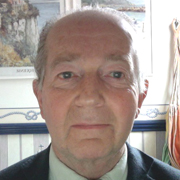Philip John

-
Emeritus Professor
Emeritus Professor
Areas of interest
- Scientific basis of natural indigo extraction from woad and tropical indigo crops - maximising yields of indigo and enhancing indigo purity
- Microbiology and optimisation of the fermenting indigo vat used for traditional, sustainable indigo dyeing
Background
Advisor and consultant to natural indigo producers and dyers worldwide.
Esteem Factors
- 2014 Invited Speaker and Discussion Leader: International Workshop on Natural Dyes - a Value Chain in Natural Dyes, Hyderabad, India.
- 2013 Invited Speaker: Reviving the tradition of Natural Indigo - Spindigo: an example in EU countries. University of Kurume, Japan.
- 2011 Invited Lecture: The Scientific Basis of Natural Indigo Extraction and Dyeing. Zhejiang Sci-Tech University, Hangzhou, China.
- 2001-2004 Coordinator of the 3.4m euro EU project, Sustainable Production of Plant-derived Indigo SPINDIGO.
Selected publications
John, P. (2009) Indigo - Extraction. In: Handbook of Natural Colorants. Bechtold, T. and Mussak, R. (eds)John Wiley and Sons, Chichester. Chapter 8, pp 105-134. ISBN: 978-0-470-51199-2 doi: 10.1002/9780470744970
John, P. Angelini, L.G. (2009) Indigo - Agricultural Aspects. In: Handbook of Natural Colorants. Bechtold, T. and Mussak, R. (eds) John Wiley and Sons, Chichester. Chapter 7, pp 75-104. ISBN: 978-0-470-51199-2 doi: 10.1002/9780470744970
Blackburn, R.S., Bechtold, T. and John, P. (2009) The development of indigo reduction methods and pre-reduced indigo products. Coloration Technology 125 (4). pp. 193-207. ISSN: 1472-3581 doi: 10.1111/j.1478-4408.2009.00197.x
Vuorema, A., John, P., Keskitalo, M., Mahon, M.F., Kulandainathan, M.A., Marken, F. (2009) Anthroquinone catalysis in the glucose-driven reduction of indigo to Leuco-indigo. Langmuir. Physical Chemistry Chemical Physics, 11 (11) pp. 1816-1824. ISSN: 1463-9076 doi: 10.1039/b814149e
Vuorema, A., John, P., Jenkins, T.A., and Marken, F. (2006) A rotating disc voltammetry study of the 1,8-dihydroxyquinone mediated reduction of colloidal indigo. Journal of Solid State Electrochemistry 10, (10) pp. 865-871. ISSN: 1432-8488 doi: 10.1007/s10008-006-0149-4
Nicholson, S.K. and John, P. (2005) The mechanism of bacterial indigo reduction. Applied Microbiology and Biotechnology, 68 (1), pp. 117-12. ISSN: 0175-7598 doi: 10.1007/s00253-004-1839-4
Nicholson, S.K. and John, P. (2004) Bacterial Indigo Reduction. Biocatalysis and Biotransformation 22 (5-6), pp. 397-400. ISSN: 1024-2422 doi: 10.1080/10242420400024490
García-Macías, P. and John, P. (2004) Formation of natural indigo derived from woad (Isatis tinctoria L.) in relation to product purity, Journal of Agricultural and Food Chemistry, 52, (26), pp. 7891-7896. ISSN: 0021-8561 doi:10.1021/jf0486803
Padden, A.N., P., Collins, M.D., Hutson, R. and Hall, A.R. (2000) Indigo-reducing Clostridium isatidis isolated from a variety of sources, including a tenth century Viking woad vat. Journal of Archaeological Science, 27 (10), pp. 953-956. ISSN: 0305-4403 doi: 10.1006/jasc.1999.0524
Compton, R.G., Perkin, S.J., Gamblin, D.P., Davis, J., Marken, F., Padden, A.N. and John, P. (2000) Clostridium isatidis colonised carbon electrodes: voltammetric evidence for direct solid state redox processes. New Journal of Chemistry, 24 (3), pp. 179-181. ISSN: 1144-0546 doi: 10.1039/a909172f
Padden, A.N., Dillon, V.M., Edmonds, J., Collins, M.D., Alvarez, N. and John, P. (1999) An indigo-reducing moderate thermophile from a woad vat, Clostridium isatidis sp. nov. International Journal of Systematic Bacteriology 49 (3), pp. 1025-1031. ISSN: 0020-7713 doi: 10.1099/00207713-49-3-1025
Padden, A.N., Dillon, V.M., John, P. Edmonds, J., Collins, M.D., and Alvarez, N. (1998) Clostridium used in mediaeval dyeing. Nature, 396 (6708), p. 225. ISSN: 0028-0836 doi: 10.1038/24290
Kokubun, T., Edmonds, J and John, P. (1998) Indoxyl derivatives in woad (Isatis tinctoria) in relation to medieval indigo production. Phytochemistry, 49 (1), pp. 79-87. ISSN: 0031-9422 doi: 10.1016/S0031-9422(97)01069-8